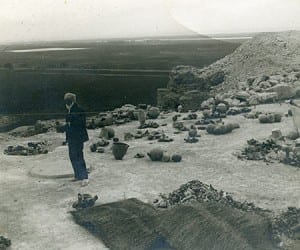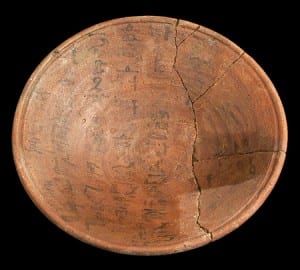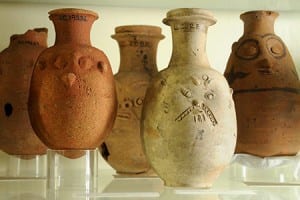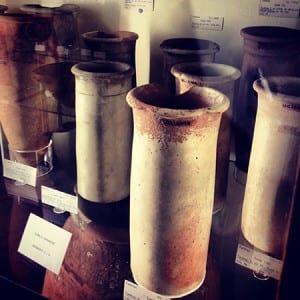Pondering Petrie’s Pots
By Alice Stevenson, on 4 February 2014
When you think about ancient Egypt what comes to mind? Plenty of things beginning with the letter ‘P’ no doubt: Pyramids! Pharaohs! Papyrus! Maybe even Petrie. But Pottery?…
Poor pottery. It is such a frequent archaeological find that it rarely excites anyone but a few specialists. Petrie himself recognized this, noting at a meeting of the Archaeological Institute on February 1 1883 that:
“On such a familiar subject as pottery, it might be supposed that there would not have been much left to be said, after the various explorers who have studied the antiquities of Egypt.”

Flinders Petrie amongst the pottery of Qau, from Caton-Thompson’s photograph album, Petrie Museum archives
Yet there is so much to be said about pottery. And, no, I don’t just mean in terms of typology, chronology or micromorphology. Such aspects are crucial parts of archaeological data analysis, but that is only a means to an end. Ceramics offer tantalizing clues about ways of life, ways of thinking, ways of doing, and ways of dealing with death.

Vessel UC16244 on which is written a rare example of a ‘letter to the dead’, dating to the late third millennium BC.
In the Petrie Museum we have an entire gallery devoted to all things pottery. What we don’t currently offer is much in the way of insight into why we have so much pottery, nor do we reveal what it can tell us about ancient Egypt or Sudan. Sure there are some dates attached to them. But in those periods that we identify what were these things for? What did these vessels contain? Where were they used? What did they mean for the people that used them?
All good questions. But as a curator my question right now is whether there is space in the gallery to offer some answers. The cases and any available storage in the Petrie are full, so there’s very little wiggle room.
There are windows of opportunity though to try out a few new approaches. So over the next year I’m going to explore a few small interventions: case highlights – watch out for a few new labels; a new pottery trail – picking out a few characters from the displays; and a series of blog contributions from pottery specialists, artists and students to share some of their thoughts about the pottery collection. So watch this space! But don’t just watch – ask. Is there a vessel that caught your eye on your visit? Want to know more about a certain ceramic artefact? Do get in touch if so, as it can feed into ongoing changes. When you think about ancient Egypt or Sudan then, think about pottery.
Alice Stevenson 4 February 2014
10 Responses to “Pondering Petrie’s Pots”
- 1
- 3
-
4
Emily Millward wrote on 9 February 2014:
Hi Alice,
The pottery section in the Petrie Museum is one of my favourite museum spaces, I even found items that I have used in my PhD there. One of my favourite pieces is currently displayed; a figurine of a woman with her arms raised (UC16126). I love that the Petrie embraces the wealth and variety of Egyptian pottery is has but I am also very excited to hear that the displays will be changing, with lighting and labels added. I think that it would be fantastic to keep some of the ‘cabinet of curiosities’ elements but working in a museum myself I understand that have less ‘wiggle-room’ is not very good for the items themselves! Could this perhaps be balanced with selecting a particular type of pottery (either thematically, chronologically etc) to focus upon quarterly? Maybe with an interpretation panel in the case and an accompanying blog post?Best of luck with all of the changes, I look forward to visiting the Petrie again soon.
Emily Millward
PhD Egyptology, University of Birmingham
Museum Collections Assistant, the Shakespeare Birthplace Trust -
6
Pondering pottery | Cakes and Ceramics wrote on 19 February 2014:

[…] so important for archaeology. Catch the first introductory post by curator Alice Stevenson here: http://blogs.ucl.ac.uk/museums/2014/02/04/pondering-petries-pots/. This promises to be a fascinating series, with lots of specialists making an […]
-
7
Emily Millward wrote on 23 February 2014:
Hi Alice,
I really have used a variety of artefacts in my thesis; largely scenes from Theban tombs, but also ceramics, faïence amulets, wooden figurines, papyrus vignettes . . .
I used several ceramic items from the Petrie Museum in my thesis; UC16126 as mentioned above and also UC18248 and UC15150. My PhD title is ‘The Mechanisms of Mourning in Ancient Egypt’ so items such as this, which I strongly believe to demonstrate gestures of mourning are really valuable to my research. They also helped me in identifying what type of ceramics showed gestures of mourning and I was then able to discover similar vessels at the museum in Birmingham. I have also used several amulets of Isis and Nephthys which I have compared to a similar Isis amulet (again showing mourning) in the Eton Myers collection (currently on loan to the University of Birmingham). One of your colleagues kindly gave me copyright permissions to use images of these items from your very helpful online catalogue – I’m really glad that I get to present them in my work.
I would love to begin publishing my work in articles when I have finished my PhD (which will be this summer) and it may be that some of the Petrie items will be possibilities, if this would be okay?
Best wishes,
Emily
PhD Egyptology, University of Birmingham
Museum Collections Assistant, the Shakespeare Birthplace Trust -
9
Emily Millward wrote on 24 February 2014:
Hi Alice,
Wonderful, I will definitely get in touch with you when I begin to think about writing-up some articles later this year. I think I will probably start with the vessels in the Petrie and these are some of my favourites and I feel that my interpretation of them could make for some interesting reading.
I will certainly think about writing something for your ‘Festival of Pots’ initiative – this sounds really interesting! I will contact you when I’ve had a think and perhaps put something together.
Many thanks for all of your help, best wishes,
Emily
PhD Egyptology, University of Birmingham
Museum Collections Assistant, the Shakespeare Birthplace Trust -
10
Pottery Project Guest Blog: Pondering Petrie’s Broken Pots | UCL UCL Museums & Collections Blog wrote on 7 March 2014:

[…] a gallery for exhibiting nice whole pots can be as challenging as trying to answer questions like: “What was their function, context of use, symbolic meaning?”. Answering these questions is also one of the objectives of pottery specialists researching in […]
 Close
Close





Hi Alice, so glad to see that pots still feature significantly in the Petrie. I wrote my PhD about the Predynastic pottery in the Manchester Museum collection in the 1980s much of it excavated by Petrie, I also worked at Memphis with Janine Bourriau and am currently working on the MK material Palestinian and Creatan pottery from Wadi Gawasis. I am also a primary school teacher and have taught adult courses on ancient Egypt for various bodies including UEA. If I can ever be of help with making pottery more glamorous and accessible please get in touch.